Disclosure: Please note that some links are affiliate links, and at no additional cost to you, we earn a commission if you make a purchase.
If you would like to support this website in some way, using these links will help do exactly that.
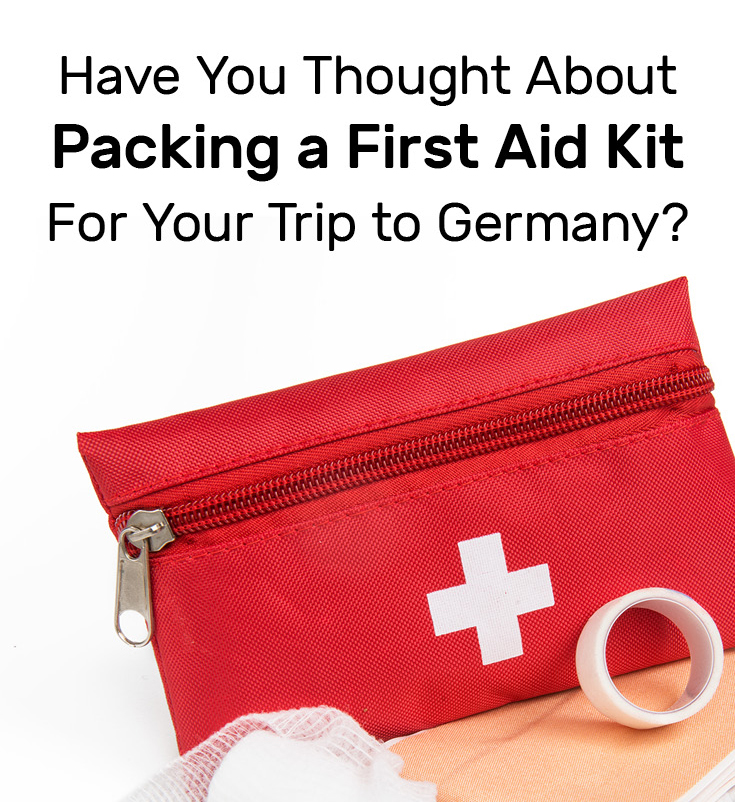
Some travelers think of everything - including packing a first aid travel kit for their vacation. Then there are travelers, who travel with a Spongebob Band Aid and an expired Aspirin package. However, any traveler can get sick, whether because of the change to a new climate, unusual food or bad hygiene on an airplane. A few things belong in any travel first aid kit. Medications for fever, pain, and inflammation, as well as medicine for constipation and diarrhea (the #1 travel sickness), are part of the basic equipment. There should also be some bandaging material, as well as sufficient sun protection products, especially if you visit Germany during the warmer months. Here are some tips for your upcoming Germany vacation.
Take as Little as Possible, But as Much as Necessary
The rule of thumb for this list: take as little as possible, but as much as necessary. Feel free to edit the list to your needs. Keep in mind that most “drugstores” in Germany (called Drogerien) do not actually carry any medication. You will have to seek an Apotheke for that. Look for this red symbol. Step inside and ask the pharmacist for help. Most of them speak a bit of English or have someone on their staff that can help with the language barrier.
Note: This list does NOT replace professional advice from your doctor or your pharmacist. Also, keep in mind that some painkillers and other medication, that is sold over the counter in the United States might need a prescription by a German doctor. Take Benadryl as an example, which has Diphenhydramine as a main ingredient. You can buy Benadryl in almost every store in the United States, but in Germany you need a prescription to pick up a package in the Apotheke. Different country, different rules. If you are not sure, take the over the counter medication with you on your trip.
Here is what I usually pack:
• Painkillers • For headaches and general pain, bring extra ones as needed. For example, a blister pack of 10 Aspirin pills will cost about $5 in a German Apotheke. Walk into an American drugstore and the $5 will buy you a 100 pack of Aspirin pills.
• Nasal Spray • The low humidity on an airplane always dries my nose out. After using nasal spray for two days, it is usually back to normal. This is my favorite nasal spray.
• Nausea & Motion Sickness • There is nothing worse than problems with your stomach and/or intestines. Grab a small pack like this. The pills are chewable and get absorbed by your system fast.
• Heartburn Relief • Vacations in different countries with new dishes and beverages leads us to eat too much and often too late in the day. This stimulates the acid production in our stomach, resulting in heartburn. I usually travel with a small package of Tums.
• Diarrhea • Another unfortunate consequence of eating unknown or unusual foods on vacation is diarrhea. It can also be caused by bacteria, for example Salmonella, which can be found in products that were not maintained at the right temperature. Grab a package of Pepto Bismol pills (not the liquid) and you should be taken care of if and when your stomach fights back.
• Band Aids • For small cuts, I prefer the Flexible Fabric Band-Aid, which is the most comfortable Band Aid I have ever used. My dad buys long strips of it and cuts them to the desired length. For travel, I prefer the pre-cut ones. I also pack a small tube of Neosporin antibiotic cream for small cuts.
And yes, you also need a prescription in Germany for an antimicrobial/antibiotic ointment like Neosporin.
• Prescribed Medication • If you have a chronic illness, make sure to pack enough pills to cover you for your entire trip, plus two extra days - you never know, you could drop a pill down the drain by accident or have a delayed flight home. Carry them on the plane in the original prescription bottle/package with your name on it and DO NOT check them in your luggage. Keep them in your purse or carry-on bag. Too many bags get lost, especially if you have a connecting flight.
• Sleep Aid • Not only might the over-the-counter medication have a totally different name in Germany, some even require a prescription by a German doctor. One of my favorite sleep aids to fight jet lag is Melatonin, which you can buy at any grocery store in the United States. Its not as easy to get in Germany, which requires consumers to be over 55 years old and have a prescription, sold as Circadin in Germany. We’ve also had good luck with ZzzQuil, and use that to try and sleep on the flight to Germany.
• For good measure, throw in a travel-size bottle of hand sanitizer, in case you find yourself without running water or want to disinfect your airplane tray table before taking off.
Two More Things
If you have an iPhone, make sure to fill out your Medical ID, so that first responders have access to your health information in case of an emergency. You can find Medical ID Health app setup instructions on Apple’s Help Page here:
For when disaster strikes during your Germany trip: Make sure to book travel insurance for your trip, since you never know what can and will happen. A recent family vacation incident was covered by less than a $100 travel insurance policy. Otherwise a weeks hospital stay including ICU station for several days would have cost us more than $25,000. Needless to say, we were very grateful for the added insurance coverage. For a quick quote (less than a minute), check our resources page and scroll to the bottom.
Have we forgotten something? Let us know what medical essentials you bring when you travel. Denise and I hope you have a safe trip!
Photo Credit: First Aid Kit Image by DLG Images shared via (CC BY 2.0).
Follow Along
If you enjoyed this article, or these topics sound interesting to you, you'll love our weekly newsletter. You'll receive the newest posts each week and exclusive access to free planning resources like ‘Packing List & Tips for 2 Weeks in Germany’ and ‘Everything You Need to Rent a Car in Germany’.
Thank you for reading!

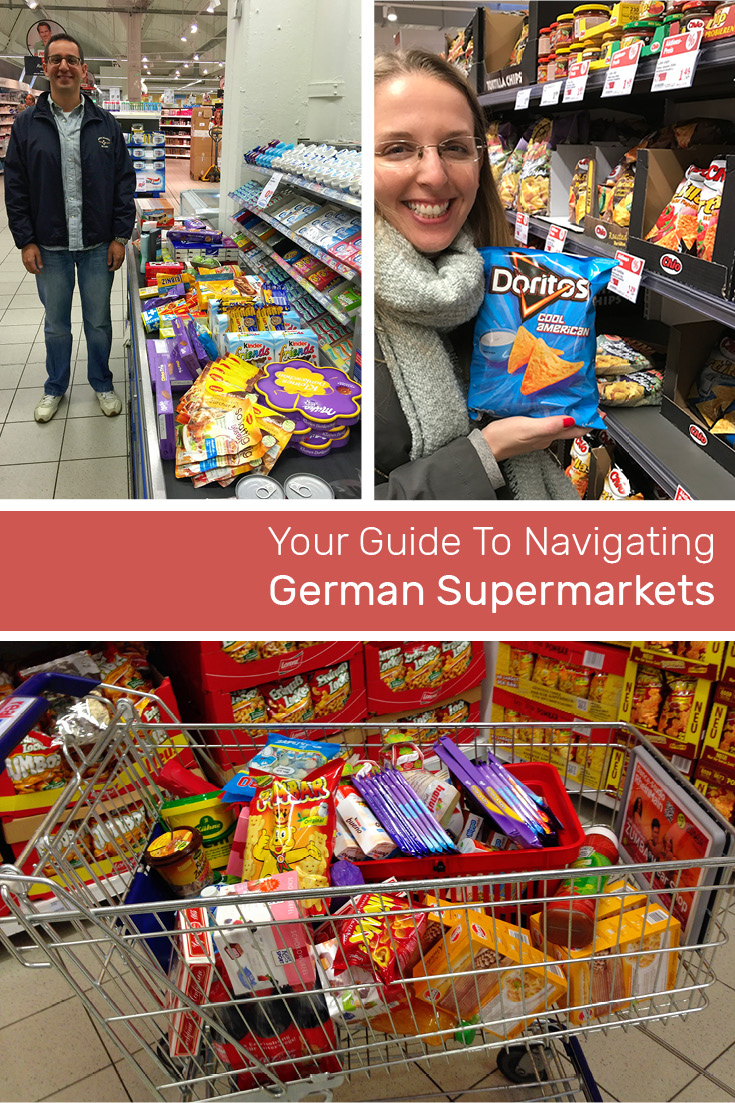
A grocery store is a grocery store, whether it is located in the United States or Germany. Yes, grocery stores in both countries sell fresh produce, bread, milk and other essentials. However, there are small differences to keep in mind before you start your shopping trip. The most convenient feature, to me is that the price that is on the tag is the final price you pay. It already includes the tax, so if you see a package of strawberries for €3.00, this will be the price you will pay at the register. Here are more helpful hints for your grocery store trip in Germany:
Why are Eggs Not Chilled?
In Germany, eggs are stored on ordinary shelves, while they are refrigerated in the United States. The simple reason: freshly laid eggs in the United States are washed for hygienic reasons before they arrive at grocery stores for sale. It is forbidden to sell eggs, that have not been washed with hot water and odorless soap in order to be germ free. In Germany it is exactly the other way round: Washed eggs are prohibited to be sold. During the washing process the natural protective layer is lost. This layer prevents bacteria and salmonella from getting into the interior of the egg. Once the protection has been washed off, eggs have to be kept in coolers.
Bring Your Own Bags
Before you head out to the store, know this: there are usually no free bags given out by German grocery stores. Germans tend to bring their own bags or folding crates (like these at The Container Store), and even pack their items themselves. If you forget your bags, you can purchase bags at the checkout register. Also, there are no packers at the end of the conveyor belt. Wal-Mart failed when they tried to introduce bagging groceries for customers in the 1990s Germany. (For more on Wal-marts in Germany, check out this article from the Huffington Post).
Store Hours & Sundays
Most grocery stores in Germany are open from 7am until 8pm. Some larger chains stay open longer, but all of them have one thing in common: closed on Sundays. This day of the week is reserved for relaxing, dining together with your family, or heading to a museum. For emergency runs on a Sunday, look for gas stations or supermarkets in a train station or at an airport. If that is too far for you, check if you can borrow some milk for your Sunday morning cereal from your neighbor.
Grocery Cart Deposits
It is very common to drive onto a grocery store parking lot in the United States and see carts scattered from customers being too lazy to return the cart to a corral. Germans came up with their own way of dealing with this. To get a grocery cart in Germany, you have to insert a €0.50 cent or €1 coin into the handle in order to release the cart. Use it for shopping in the store and later return it the same place you received it. Insert the metal plug into the back of the handle and get your coin back. This saves grocery store employees from having to collect carts and gives you some exercise.
Why is the Milk Not Being Refrigerated?
The United States had fresh milk deliveries by a milkman for decades. The milkman stopped by several days a week, took the empty milk bottles and left fresh bottles of milk at the doorstep. This milk has to be refrigerated, since it is “only” pasteurized, meaning it is heated up to about 160 degrees Fahrenheit and will be good for about 2 to 3 weeks in the fridge. Contrary to that, more than 65% of the milk in Germany is treated with Ultra-high temperature processing at 275 degrees Fahrenheit, which basically sterilizes the milk. This kind of milk can be sold non-refrigerated and has a shelf life of 6 to 9 months. You can also buy some milk from the refrigerated section in a Germany supermarket in case you want to do a taste test and compare a pasteurized and a ultra-high heated milk.
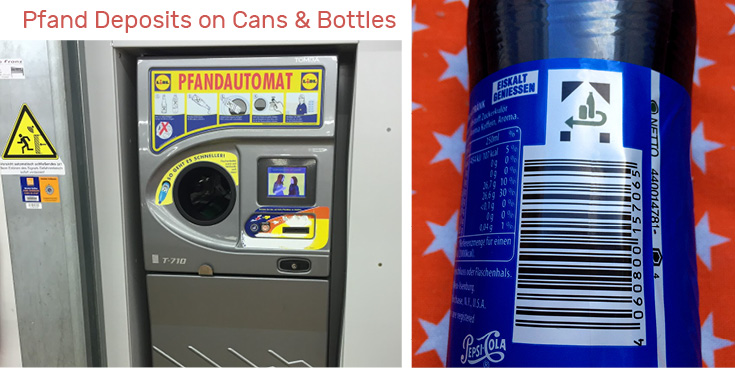
Pfand Deposits on Cans & Bottles
To promote recycling, in 2003 the ever-clever, thrifty Germans implemented a container deposit legislation, also known as Pfand [pronounced pf‿ant]. If you buy a single-use container in form of a can of soda or a water in a plastic bottle, you will pay a €0.25 deposit, which will be refunded when you bring the container back to a supermarket or shop. Sometimes a real person will refund your deposit, sometimes you have to push your bottle or can into one of these deposit return machine and get a voucher printed. Either use the voucher in the store or go to the cash register to have the amount paid out to you in cash. When you throw that bottle away, you're also throwing away your €0.25. The deposit legislation does not cover containers for juice, milk-products, wine, spirits, or liquors.
Did we forget other differences that you have noticed? Let us know in the comments!
Follow Along
If you enjoyed this article, or these topics sound interesting to you, you'll love our weekly newsletter. You'll receive a free Germany Packing list for signing up, and you'll receive each week's newest posts every Friday. Thank you for reading!

*Although our content is available for free, this blog currently earns as an Amazon associate. You’ll see links that are preceded by "(associate link)", and at no additional cost to you, we earn a commission if you make a purchase. All opinions and recommendations are our own, and come from experience with the product or service.
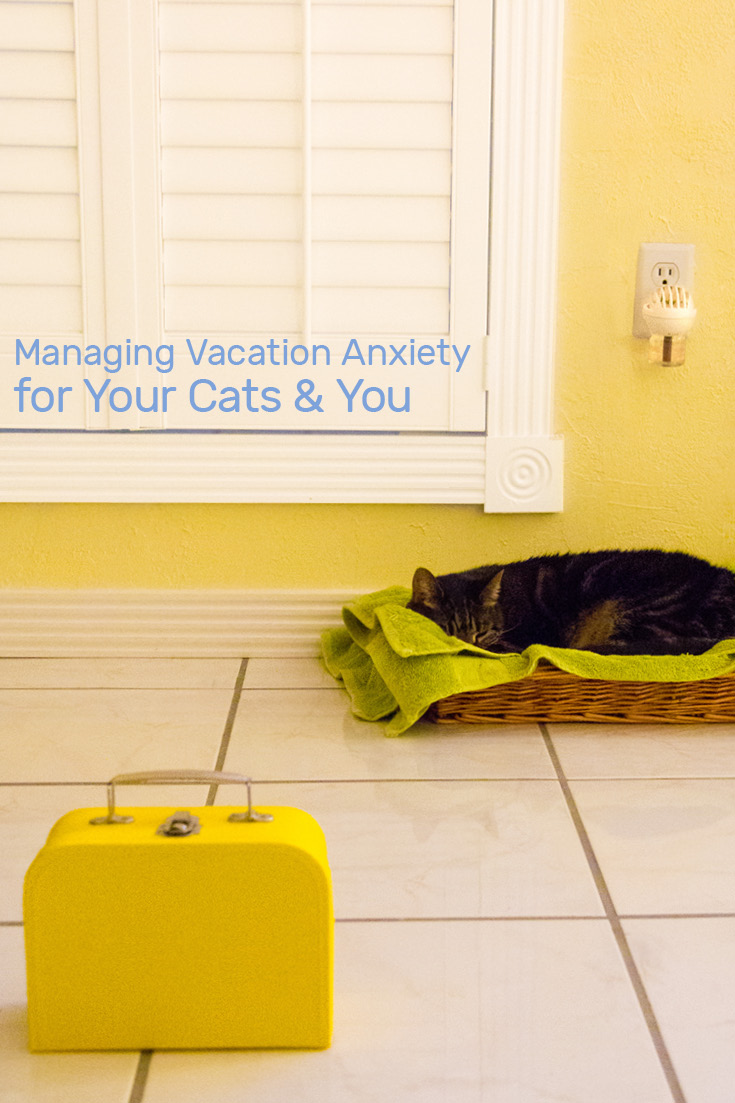
Every year the hardest part of our trip is leaving behind our two cats, Katze and Jayla. They’ve seen the suitcases load up and wheel out, and when you try to say goodbye they’ll hide under the bed, as if that will change the impending situation. Most vacations, I leave the house in tears. My worst fear is that something happens to us on our trip, and as a result, Katze and Jayla will forever think they did something wrong and we abandoned them. This is what I do to manage their anxiety and mine, when vacation time comes.
Comfort Zone® with Feliway® Diffuser Kit
One year, when we returned from vacation, Katze had been so stressed over us leaving she gave herself a urinary tract infection. No fun! I didn’t know this was possible, and we did everything as we had normally done. My Mom came by in the evenings to give them dinner and spend time with them. The litter box was spotless. The vet said it was definitely anxiety-related. Since then, whenever we go out of town on vacation, we plug in a (associate link) Comfort Zone® Feliway® diffuser into the outlet next to her favorite sleeping spot. That was four years ago, and we've used it for every vacation since. Katze hasn't had a UTI since.
We had heard about Feliway® from my Mother-in-law, who had issues with her cat marking their suitcases while they tried to pack. When that was plugged in, he stopped marking. My Mom has a crazy cat who has a diffuser plugged in all the time. The Feliway® diffuser alleviated the confrontations she had with my Mom’s other, more mentally-balanced cats. Its well loved by our feline family, and I hope it brings your family relief too!

Nest Cam Indoor
This is definitely relief more for my own anxiety than the cats’. They have no idea what (associate link) Nest Cam Indoor is. For me, the benefit is that at any time of day, I can open the app on my phone, and I can see that the house is ok, possibly see Katze and Jayla, and even hear my ticking clock in the background. It's a visual relief that arrests my anxiety in it's place. One time I caught Jayla and my Mom watching a NASCAR race together. I knew because I could see Jayla’s face and eyes following the cars on the screen. When I was feeling homesick and missing them, that was priceless. We have one that we bought several years back, and is still supported by the current app. Its something that while its expensive at first, it will last a while. We position it by our TV in the living room, and it covers most of the hallways and the couch they love.

Securing Pet Sitters
If you have family or friends around that you trust to check on the cats every day, great. Maybe they’d even be game to send photos and/or video from time to time too. Spend time before the trip to make sure they understand any feeding quirks. That’s often how cats will show they’re upset, is by eating less or turning down treats that they’d normally never miss. Jayla has had several teeth removed because of bad genetics, and she needs higher food bowls that work with her, not against her, when she’s trying to eat her wet food. We make sure the caretaker knows about that, and that it's ok if Katze eats Jayla’s leftovers. Typically the first few days we’re gone, Jayla will turn down wet food in protest of the situation. Katze has turned down her wet food if it's not chopped up like she normally has it. They’re our furry divas, and we love them.
If you don’t have family or friends nearby that can watch them, it's time to bring in the professionals! Visit the website for the National Association of Professional Pet Sitters (NAPPS) to begin your search. It will help locate nearby licensed and insured pet sitters. It's a good indication that who you are hiring is responsible and takes their profession serious if they’ve become members of the NAPPS. If no one is registered in your area, ask your veterinarian for a referral.
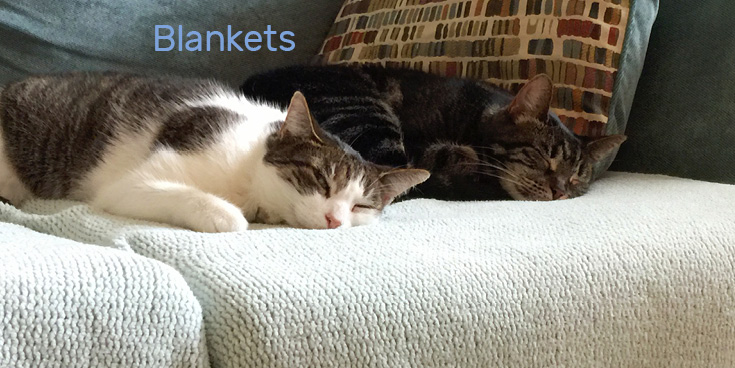
Blankets
Normally our couch throw blankets are folded up on the arms of the couch, but when we’re away from home, I spread them out flat in a few places, one where Jayla lays a lot, and another on our bed. Two reasons, one, if the girls have anxiety-caused upset stomach episodes, or their well-meaning-family-member-turned-pet-sitter has given them too many treats, the blankets protect the furniture and are easier to wash. The second reason being it's an additional comfort source for them that they can burrow into if they wish.
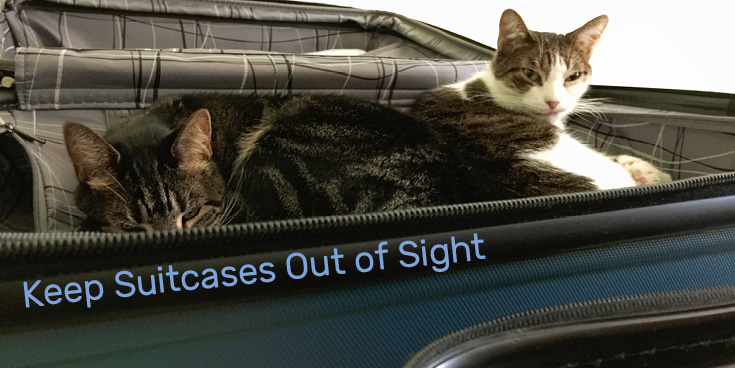
Pack in Another Room
Our cats definitely understand what a suitcase signifies. One time Sebastian got down our biggest suitcase from the attic, and set it out in the hallway overnight. Jayla left us a smelly present inches away from the suitcase for us to discover the next morning. Since then, we try to sneak the suitcases through the house into the guest bedroom where we can close the door. This isn’t usually too hard, when the cats are out in the catio it's easy to get things tucked away out of sight. Since Sebastian likes to start putting things away for the trip sometimes a month ahead of time, it's better that the cats don’t even know it's vacation time. I would hate for them to be anxiously anticipating our trip for that long. We typically will bring out the suitcases from the guest bedroom for final packing the day before we leave.
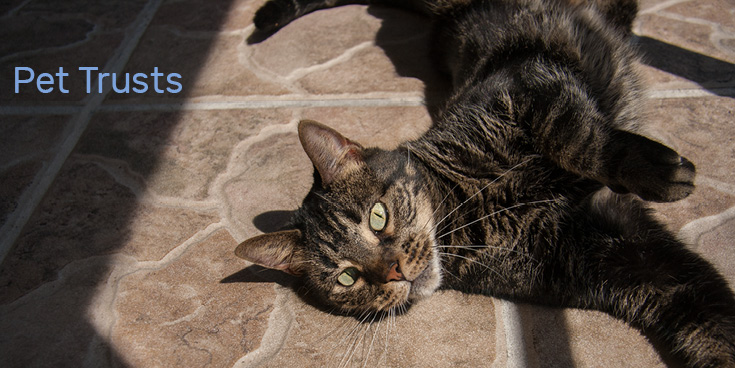
Pet Trust
At the first sign of turbulence on the flight, my panicked thought is “Oh No! What will happen to the cats!” This is something we’ve been talking about doing forever, and plan to do. You can legally make plans for your pets in the event something happens, and even set aside a trust fund for their care if you’re not quite sure that your possible caretaker would have enough funds to support them. If you’ve never considered this before, here’s a Pet Trust Primer from the ASPCA I recommend looking at to get you started.
How Do You Manage?
Do you have other tricks up your sleeve for managing travel anxiety for your cats and you? Do share! Comment below, or reply via email. Every little bit helps!
Follow Along
If you enjoyed this article, or these topics sound interesting to you, you'll love our weekly newsletter. You'll receive a free Germany Packing list for signing up, and you'll receive each week's newest posts every Friday. Thank you for reading!

